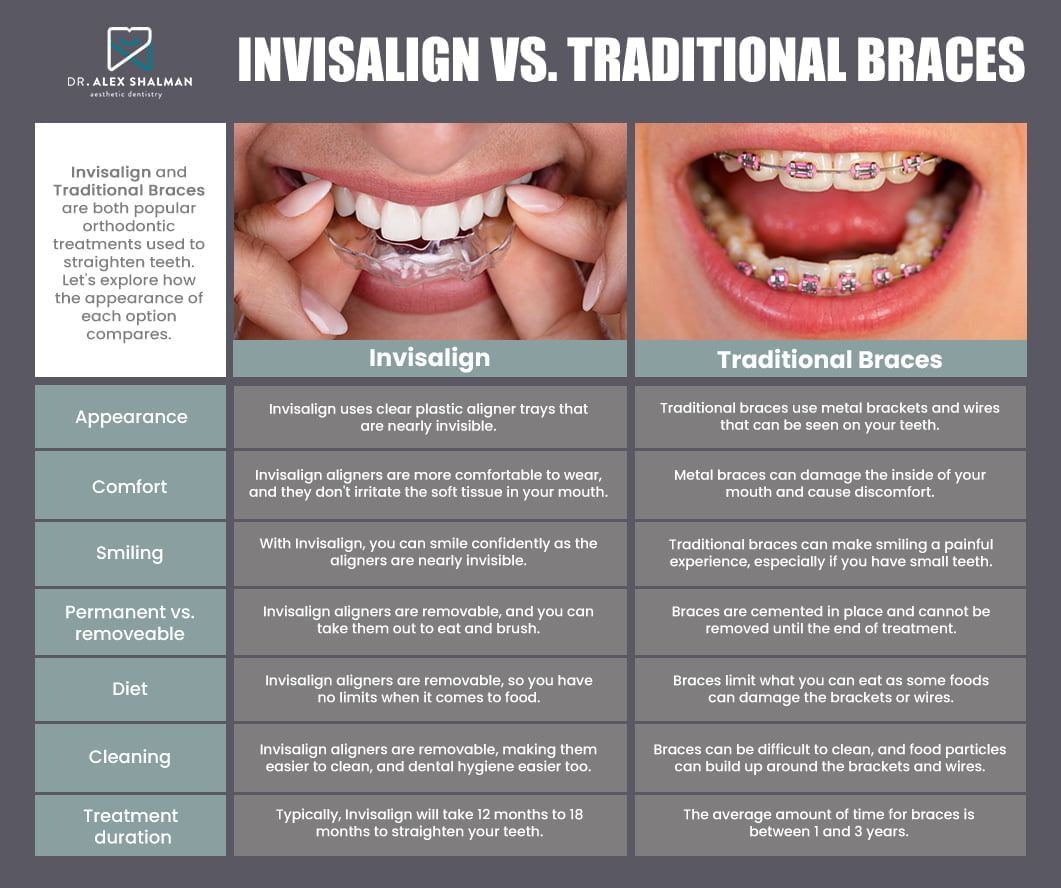Invisalign vs. Standard Braces: Which Option Is Right for You?
When thinking about orthodontic treatment, the choice between Invisalign and standard dental braces presents numerous essential elements that merit careful assessment. Invisalign provides a discreet option with detachable aligners, while conventional braces provide a more visible yet effective service for extreme misalignment.
Overview of Therapy Alternatives

In contrast, standard dental braces are composed of metal braces and cables that are bonded to the teeth. This approach uses constant pressure over time to achieve placement. While reliable for complicated orthodontic problems, conventional dental braces call for routine check outs for modifications and can position obstacles in maintaining dental health due to the problem of cleansing around cables and braces.
Both options have their qualities, and the option commonly hinges on details dental problems, lifestyle preferences, and individual conformity. Inevitably, seeking advice from an orthodontic specialist is vital for identifying the most suitable therapy plan tailored to individual requirements. Understanding the subtleties of each option can dramatically influence the total success of orthodontic treatment.
Visual Factors To Consider
A substantial aspect affecting the selection between Invisalign and traditional dental braces is the aesthetic appeal each therapy uses. Invisalign aligners are crafted from clear plastic, making them virtually invisible when put on.
In comparison, standard dental braces contain steel brackets and cables, which can be much more noticeable. While improvements in orthodontic innovation have brought about the growth of smaller braces and tinted elastics, traditional braces still preserve a more conspicuous profile. For some individuals, the presence of braces might prevent them from looking for necessary treatment.
Eventually, the choice in between Invisalign and typical braces may hinge on personal preferences concerning looks. Individuals that prioritize discernment frequently favor Invisalign, while those that are much less worried regarding presence might choose traditional braces. Understanding the visual implications of each alternative is essential for making an educated choice that lines up with one's way of life and choices.
Convenience and Convenience

In regards to comfort, Invisalign aligners are detachable, allowing individuals to appreciate their favored foods without constraint and maintain ideal oral health. Brushing and flossing are streamlined, as the aligners can be taken out throughout these routines, whereas standard braces need mindful navigating around braces and cords.
In addition, Invisalign's dynamic system enables for fewer orthodontic sees. Clients typically receive several collections of aligners at as soon as, which can simplify the therapy process and minimize time invested in the orthodontist's chair. In contrast, conventional dental braces necessitate regular modifications, making them much less click here to find out more hassle-free for those with hectic routines. Invisalign. Generally, the comfort and ease of Invisalign make it an appealing choice for several individuals looking for orthodontic therapy.
Therapy Period and Effectiveness
While both Invisalign and typical dental braces work in correcting dental misalignments, the period of therapy can vary considerably between both alternatives. Generally, Invisalign treatment can take anywhere from 12 to 18 months, relying on the complexity of the case. The clear aligners function by slowly moving teeth into their wanted placements, and routine follow-ups with an orthodontist aid ensure development stays on the right track.
In More Bonuses contrast, standard dental braces typically call for a longer dedication, generally varying from 18 months to 3 years. This results from their fixed nature and using braces and cables, which can be extra effective for intricate instances and severe imbalances (Invisalign). The therapy efficiency of conventional braces is well-documented, as they permit exact modifications and greater control over tooth movement
Eventually, the selection in between Invisalign and conventional braces might pivot on both the awaited therapy period and the particular oral issues available. Consulting with an orthodontist is vital, as they can supply tailored suggestions based on individual needs, ensuring the picked approach lines up with preferred timeframes and end results.
Cost Contrast and Insurance Coverage Alternatives
Cost plays a substantial duty in the decision-making process for people considering orthodontic treatment, whether going with Invisalign or traditional dental braces. Typically, the expense of Invisalign varieties from $3,000 to $8,000, while standard braces typically cost between $2,000 and $6,000. Aspects affecting these expenses consist of the complexity of the instance, the period of therapy, and geographical location.
Numerous oral insurance policy strategies supply partial protection for orthodontic therapies, yet the specifics can vary extensively. Typically, traditional braces may be extra frequently covered by insurance policy strategies contrasted to Invisalign, which some insurance providers classify as a cosmetic treatment.
Additionally, numerous orthodontic methods provide flexible settlement strategies, making both treatment alternatives extra obtainable. Patients must ask about possible financing alternatives and price cuts for in advance repayments. Evaluating the overall cost, consisting of insurance coverage benefits and layaway plan, is vital for making an educated choice that aligns with both visual preferences and budget plan considerations.

Verdict
In recap, the choice in between Invisalign and standard braces depends upon several elements, including aesthetic preferences, comfort, therapy period, and price. Invisalign supplies a very discreet, removable choice that promotes dental hygiene and nutritional flexibility, while conventional braces might be better for intricate dental problems and often come with a lower cost point. Eventually, consultation with an orthodontist is necessary to assess individual conditions Web Site and establish one of the most appropriate therapy choice for accomplishing optimal dental placement.
When taking into consideration orthodontic therapy, the choice in between Invisalign and traditional braces presents numerous crucial elements that warrant cautious evaluation.Comparing Invisalign and traditional braces exposes distinct therapy choices for orthodontic modification.While both Invisalign and conventional braces are effective in fixing dental misalignments, the period of treatment can vary substantially in between the 2 alternatives.Expense plays a substantial duty in the decision-making procedure for people considering orthodontic treatment, whether opting for Invisalign or traditional dental braces.In summary, the choice between Invisalign and conventional braces pivots on numerous elements, consisting of aesthetic choices, comfort, treatment duration, and price.